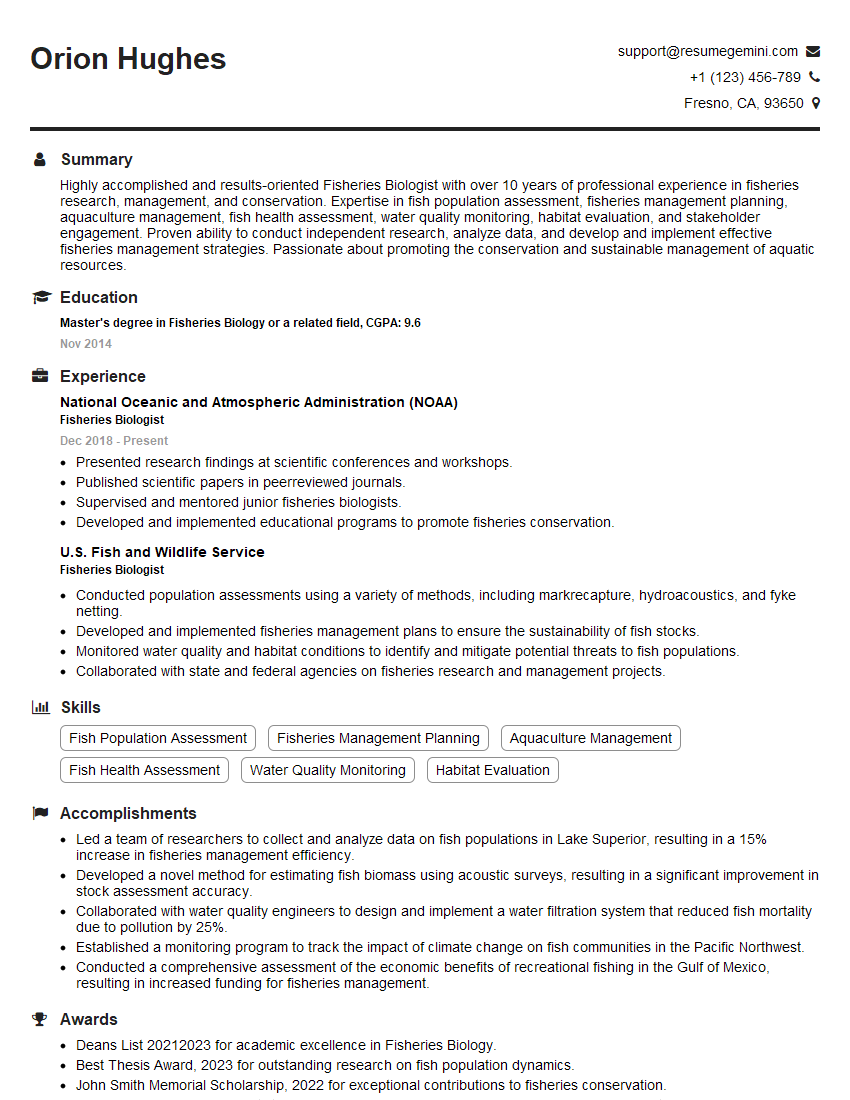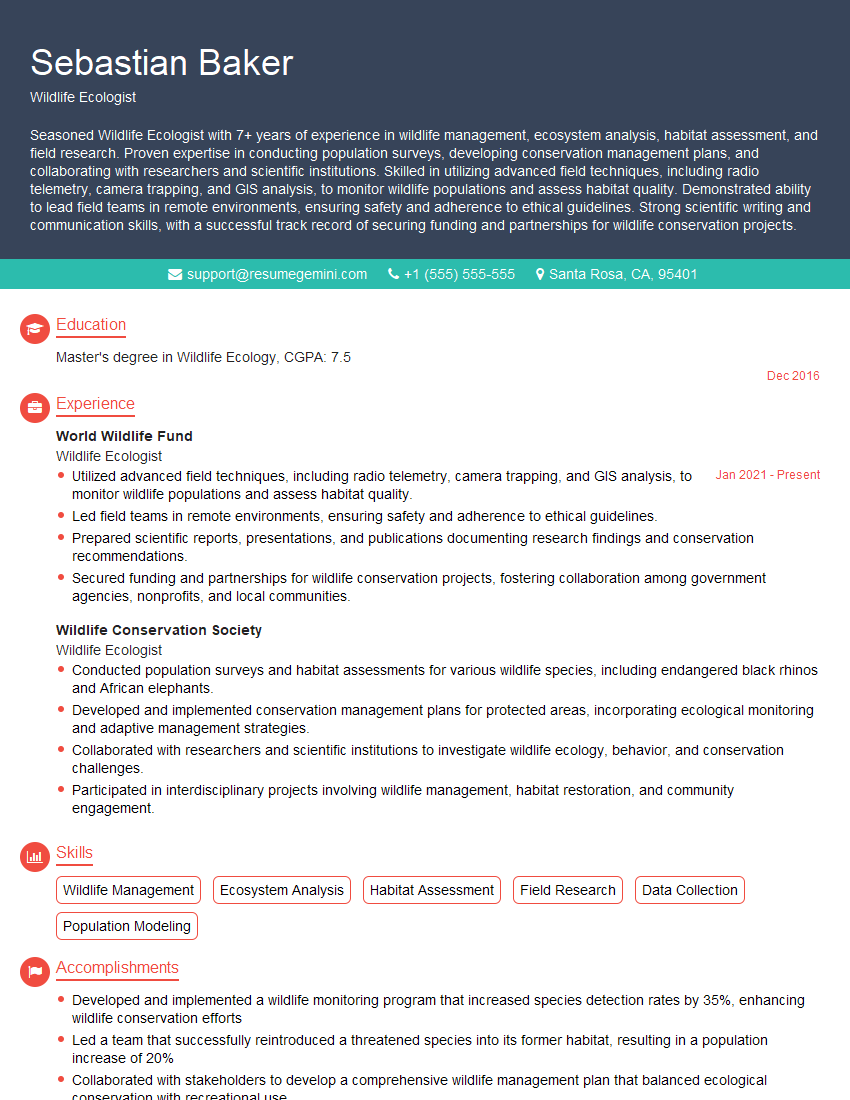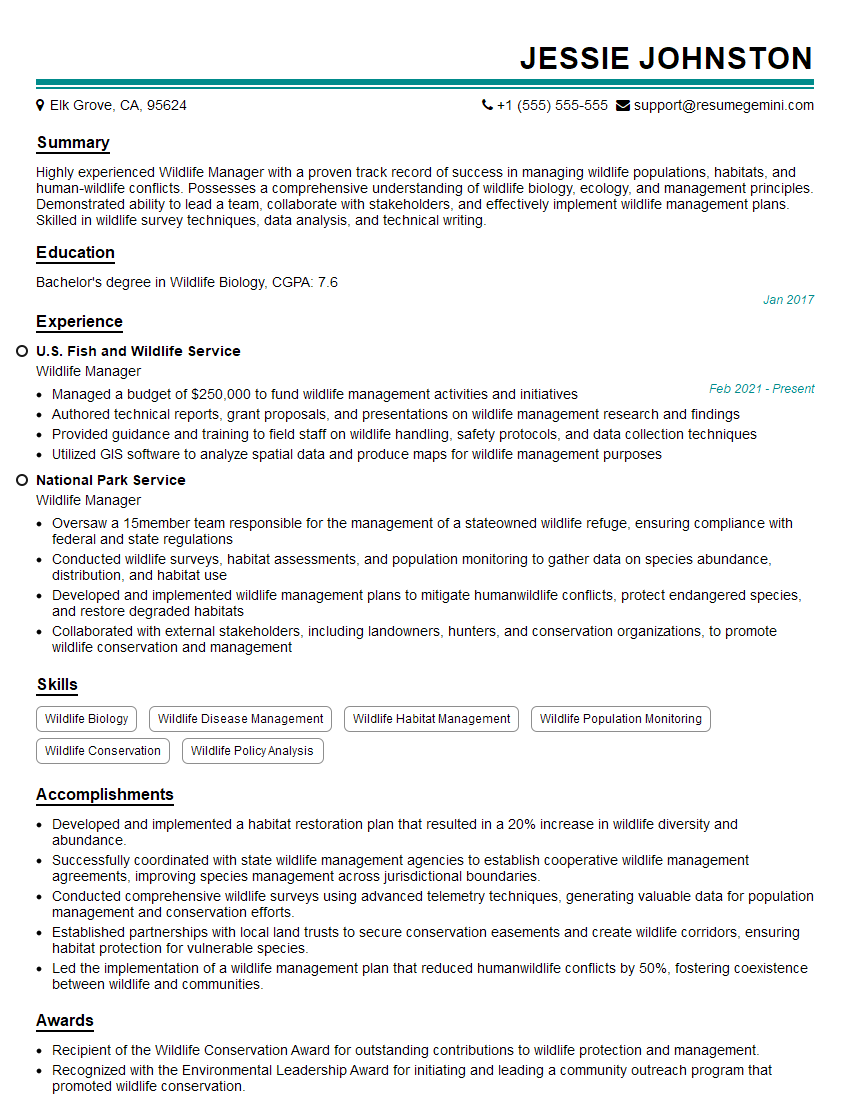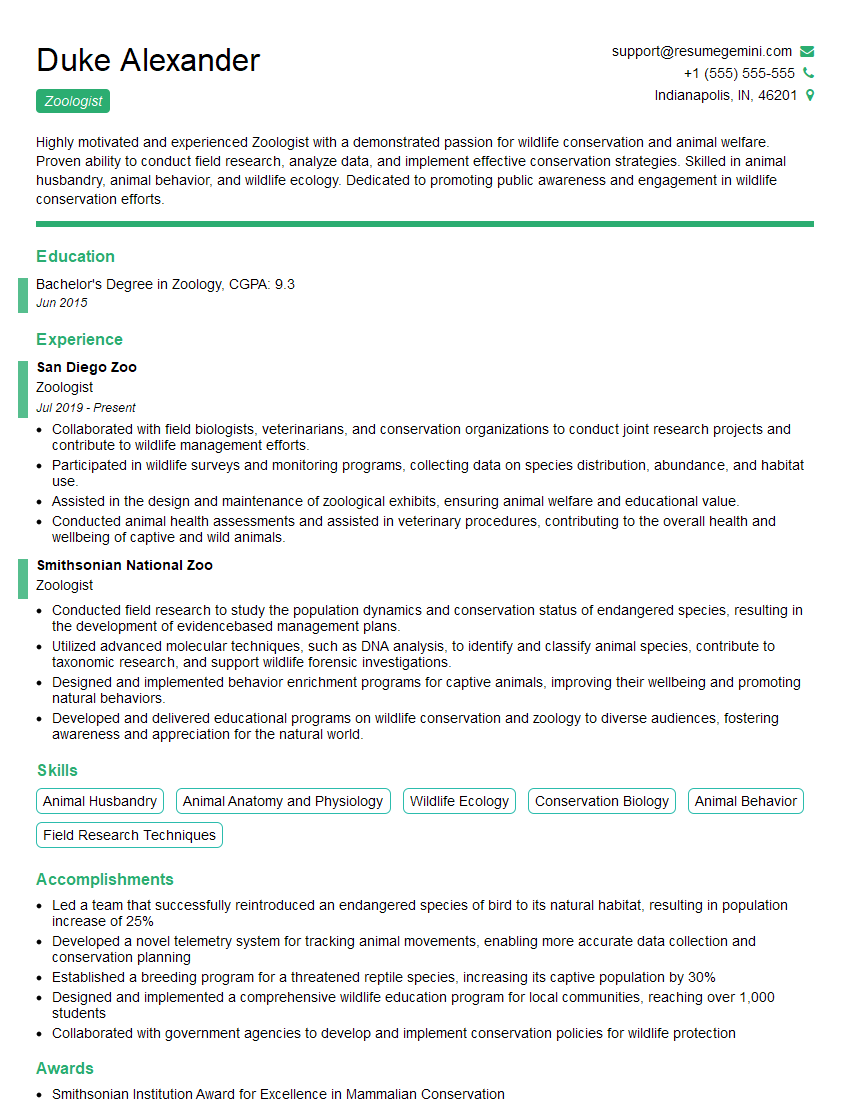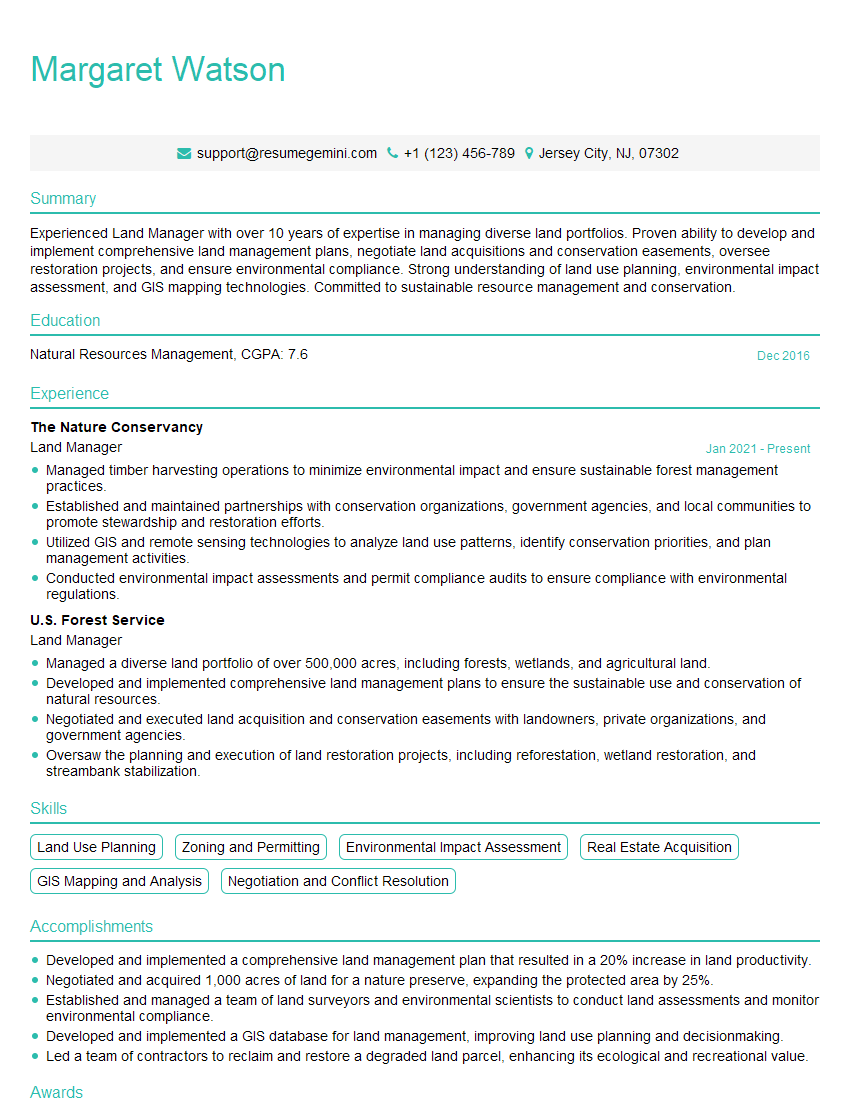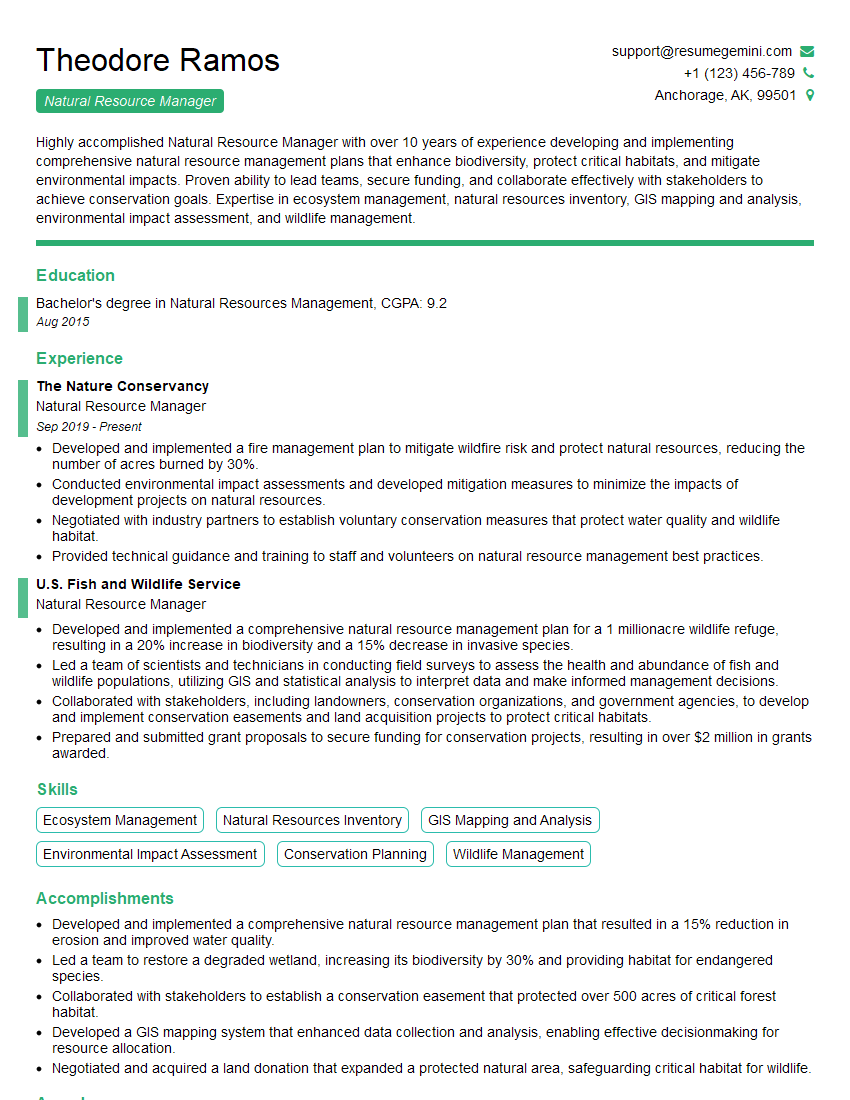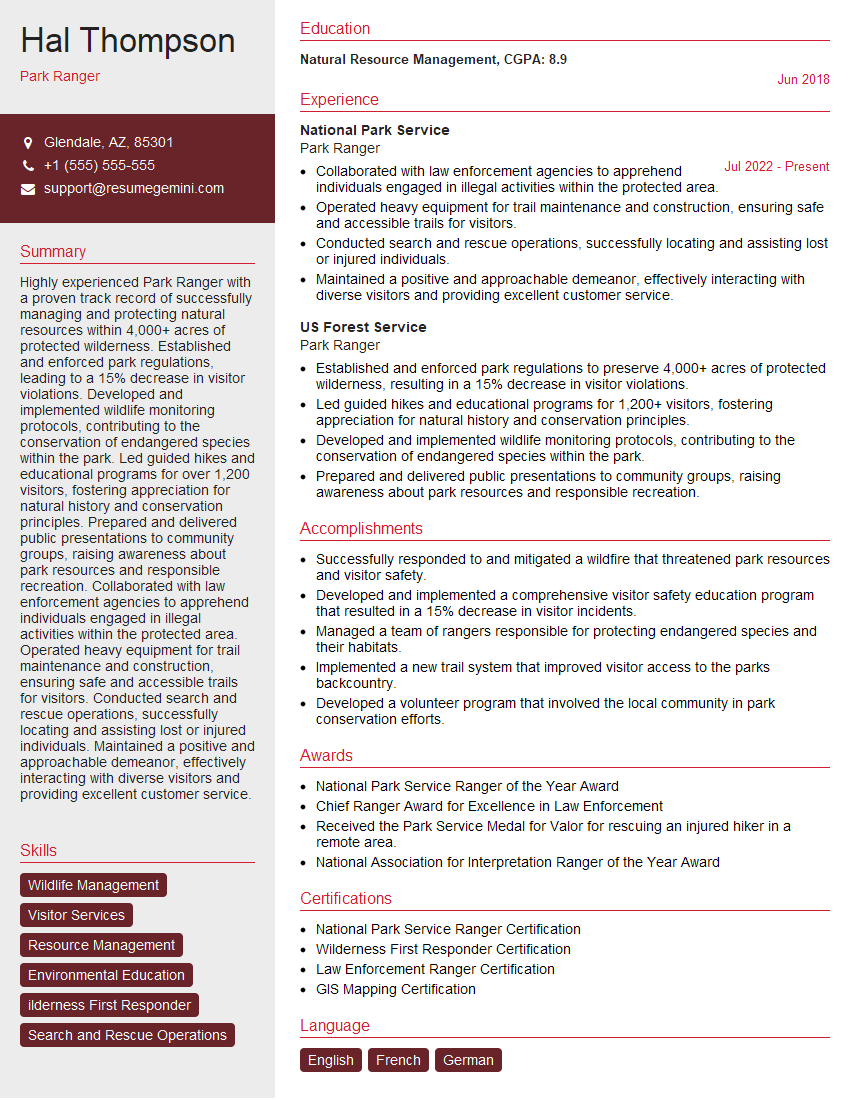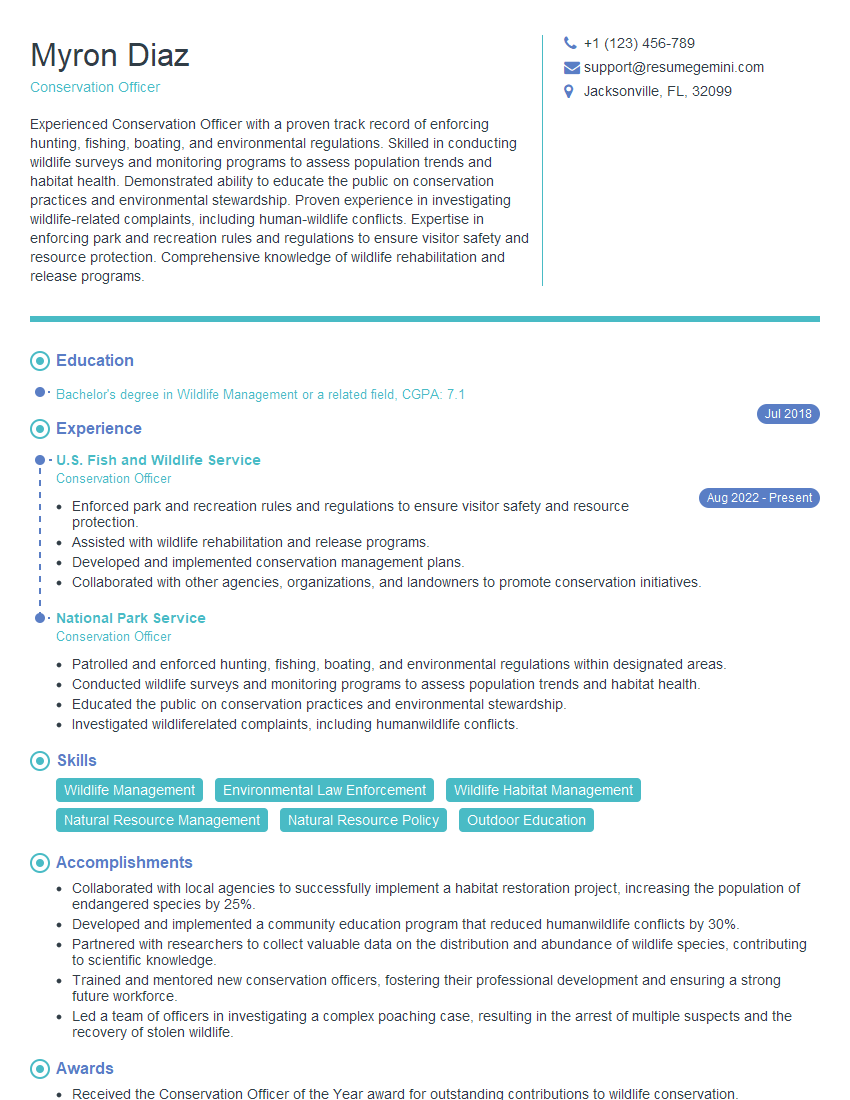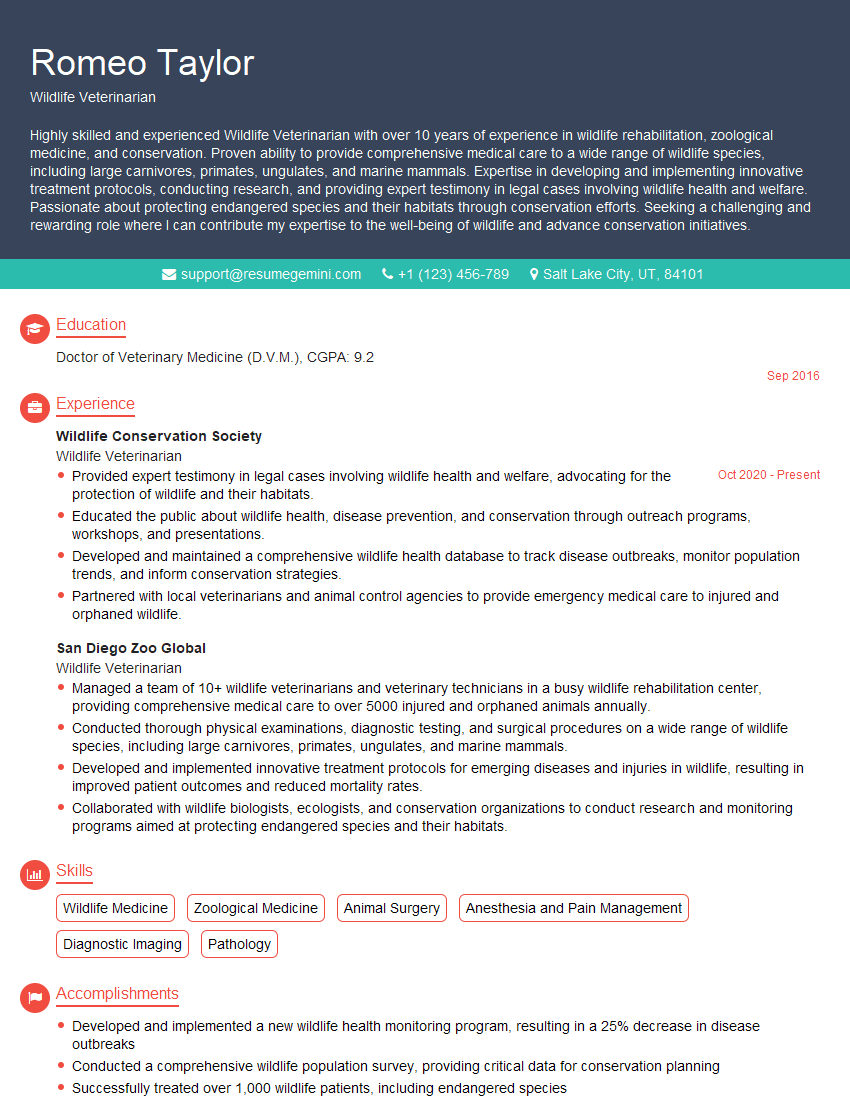Preparation is the key to success in any interview. In this post, we’ll explore crucial Wildlife and Habitat Management interview questions and equip you with strategies to craft impactful answers. Whether you’re a beginner or a pro, these tips will elevate your preparation.
Questions Asked in Wildlife and Habitat Management Interview
Q 1. Describe your experience with habitat restoration techniques.
Habitat restoration is the process of repairing damaged or degraded ecosystems to their natural state or a more desirable condition. My experience spans a wide range of techniques, tailored to specific ecosystem needs. This includes:
- Active restoration: This involves direct intervention, such as replanting native vegetation, removing invasive species, and restoring hydrological processes. For instance, I worked on a project restoring a riparian zone along a degraded river. We planted native willow and cottonwood trees to stabilize the banks, improve water quality, and provide habitat for fish and other wildlife.
- Passive restoration: This involves allowing natural processes to restore the habitat, often with minimal human intervention. An example would be allowing a naturally fire-dependent ecosystem to recover after a controlled burn, ensuring the fire regime remains appropriate for the species.
- Bioremediation: Utilizing living organisms to clean up polluted environments. We used specific types of plants to remediate heavy metal contamination in a former mining site, improving the soil quality to support plant growth.
Successful habitat restoration requires a thorough understanding of the ecosystem’s history, its current condition, and the limiting factors affecting its recovery. It’s a long-term commitment requiring careful monitoring and adaptive management.
Q 2. Explain the principles of wildlife population monitoring.
Wildlife population monitoring is crucial for understanding population trends, identifying threats, and guiding conservation efforts. The principles involve:
- Defining objectives: Clearly stating the goals of the monitoring program, such as estimating population size, assessing habitat use, or tracking the effectiveness of management actions.
- Choosing appropriate methods: Selecting methods based on the species, habitat, and available resources. This can range from direct counts (e.g., censuses of readily observable animals like birds), mark-recapture techniques (for elusive species), to indirect methods such as scat analysis or track counts.
- Data collection and analysis: Employing rigorous data collection protocols to minimize bias and ensure accuracy. Statistical analysis is essential for interpreting the data and making inferences about population trends.
- Long-term monitoring: Establishing long-term monitoring programs to detect changes over time and assess the success of conservation efforts. This allows us to observe population fluctuations in relation to environmental changes or management interventions.
For example, I’ve used camera trapping to monitor elusive species like jaguars, analyzing the images to estimate population density and home range size. The consistent, long-term data collection provides invaluable insights into population dynamics and helps inform conservation strategies.
Q 3. How do you assess the impact of human activities on wildlife habitats?
Assessing the impact of human activities on wildlife habitats requires a multi-faceted approach. It involves:
- Habitat mapping and analysis: Using GIS (Geographic Information Systems) and remote sensing to map habitats and assess changes over time due to factors like deforestation, urbanization, and agriculture.
- Species distribution modeling: Predicting the distribution of species based on environmental variables and human impacts, such as road density or proximity to human settlements. This helps us understand how changes affect a species’ ability to thrive.
- Field surveys and monitoring: Conducting surveys to monitor wildlife populations and their response to human activities. For example, we might study the impact of noise pollution from a highway on the breeding success of birds.
- Impact assessment studies: Conducting formal impact assessments of proposed developments, such as roads or dams, using standardized methodologies. This allows for proactive mitigation measures to minimize negative effects.
A specific example involves a project where we assessed the impacts of a proposed wind farm on a bat population. By carefully examining the potential habitat overlap and conducting acoustic monitoring during construction, we were able to recommend mitigation strategies to minimize bat mortality.
Q 4. What are the key factors influencing species distribution?
Species distribution is influenced by a complex interplay of factors, broadly categorized as:
- Abiotic factors: These are non-living components of the environment, such as climate (temperature, precipitation), topography (elevation, slope), soil type, and water availability. For example, a species may only be found in areas with a specific rainfall pattern.
- Biotic factors: These are living components, including interactions with other species such as predation, competition, parasitism, and mutualism. For instance, a predator’s presence can limit the distribution of its prey.
- Anthropogenic factors: Human activities like habitat alteration, pollution, and climate change significantly influence species distributions. For example, urbanization can fragment habitats, isolating populations and reducing genetic diversity.
Understanding these factors is crucial for predicting how species distributions may shift in response to climate change or habitat modification. We utilize ecological niche modeling techniques to explore these interactions and predict future distributions.
Q 5. Discuss different methods for controlling invasive species.
Controlling invasive species requires a multifaceted approach tailored to the specific species and ecosystem. Methods include:
- Mechanical control: Physically removing invasive species, such as pulling weeds or cutting down trees. This is effective for small infestations but can be labor-intensive for large areas.
- Chemical control: Using herbicides or pesticides to kill invasive species. This method needs careful consideration of non-target effects on native species and the environment.
- Biological control: Introducing natural enemies, such as predators, parasites, or diseases, to control invasive populations. This method requires extensive research to ensure the introduced species does not become another invasive threat.
- Integrated pest management (IPM): Combining several control methods to maximize effectiveness and minimize negative impacts. IPM prioritizes prevention and monitoring, moving toward more intensive control measures only when necessary.
For example, in controlling an invasive plant, we might use a combination of herbicide application followed by replanting native species to prevent re-invasion. The success of any control method depends on its integration into a broader habitat management strategy.
Q 6. How do you design and implement a wildlife management plan?
Designing and implementing a wildlife management plan is a systematic process that involves:
- Defining objectives: Clearly stating the goals of the management plan, such as maintaining or restoring populations of a target species, enhancing habitat quality, or reducing human-wildlife conflict.
- Needs assessment: Assessing the current status of the target species, their habitat, and the relevant threats. This might involve conducting population surveys, habitat assessments, and stakeholder consultations.
- Developing management strategies: Designing specific management actions based on the needs assessment. This may include habitat restoration, population augmentation, hunting regulations, or predator control.
- Implementation: Carrying out the planned management actions, ensuring that they are implemented effectively and efficiently.
- Monitoring and evaluation: Regularly monitoring the effects of the management actions and evaluating their success. Adaptive management principles guide adjustments to the plan based on ongoing monitoring data.
A good example is a plan to manage deer populations in a suburban area. This might involve a combination of habitat management (creating forested buffers) and hunting regulations to maintain a healthy deer population while mitigating human-wildlife conflicts.
Q 7. Explain your understanding of carrying capacity in wildlife populations.
Carrying capacity refers to the maximum population size of a species that a particular habitat can sustainably support over a given period. It’s not a fixed number; it fluctuates based on factors such as resource availability (food, water, shelter), environmental conditions, and interactions with other species.
Understanding carrying capacity is crucial for effective wildlife management. If a population exceeds its carrying capacity, it can lead to resource depletion, increased competition, decreased reproductive success, and ultimately, population decline. Conversely, a population far below carrying capacity may indicate limiting factors that need to be addressed.
For example, in a park with abundant resources, the carrying capacity for deer might be relatively high. However, if disease outbreaks or severe winters reduce resource availability, the carrying capacity would decrease. We use population models and field data to estimate carrying capacity, always bearing in mind that it’s a dynamic rather than a static value.
Q 8. Describe your experience with GIS software in wildlife management.
GIS, or Geographic Information Systems, software is an indispensable tool in modern wildlife management. It allows us to visualize, analyze, and manage spatial data related to wildlife populations, habitats, and human impacts. My experience spans several years and includes using software like ArcGIS and QGIS for a variety of tasks.
- Habitat Mapping: I’ve used GIS to create detailed maps of various habitats, identifying crucial areas for different species. For example, I mapped critical riparian zones for a threatened amphibian species, allowing for targeted conservation efforts.
- Population Modeling: GIS facilitates the creation of spatial population models. By integrating GPS collar data from animals with habitat maps, we can predict population trends and identify areas with high densities or dispersal bottlenecks. This allows us to focus management efforts where they’re needed most.
- Connectivity Analysis: Understanding how wildlife moves across a landscape is critical. I’ve employed GIS tools like circuit theory and least-cost path analysis to identify wildlife corridors and potential barriers to movement, informing landscape planning and mitigation strategies.
- Human-Wildlife Conflict Mitigation: By overlaying human land use data with wildlife range maps, we can pinpoint areas of potential conflict (e.g., crop raiding by elephants). This helps develop solutions like habitat restoration or improved land use planning to reduce conflicts.
In short, GIS is not just a mapping tool, it’s a powerful analytical platform that informs almost every aspect of effective wildlife management.
Q 9. How do you balance conservation efforts with economic development?
Balancing conservation with economic development is a crucial and often challenging aspect of wildlife management. It requires a nuanced approach that recognizes the interconnectedness of ecological and socioeconomic systems. The key is finding solutions that are both environmentally sustainable and economically viable.
- Sustainable Tourism: Well-managed ecotourism can generate significant revenue for local communities while simultaneously promoting conservation. This requires careful planning to minimize the impact of tourism on wildlife and habitats.
- Payments for Ecosystem Services (PES): These programs compensate landowners for adopting land management practices that benefit biodiversity. For example, landowners might receive payments for maintaining forest cover that provides habitat for endangered species or watershed protection.
- Integrated Land Use Planning: This approach involves incorporating biodiversity considerations into land use decisions. It might involve designating protected areas, creating buffer zones, or developing zoning regulations that minimize the negative impacts of development on wildlife.
- Community Engagement: Successful conservation initiatives often involve collaborating with local communities. By understanding their needs and aspirations, we can develop projects that benefit both people and wildlife. For instance, involving communities in the management of protected areas can lead to increased participation and a sense of ownership.
Ultimately, finding this balance involves negotiation, compromise, and a commitment to long-term sustainability. It requires collaboration among various stakeholders, including government agencies, conservation organizations, businesses, and local communities.
Q 10. What are the challenges associated with endangered species recovery?
Endangered species recovery is fraught with challenges, often stemming from a complex interplay of factors. Some of the most significant include:
- Habitat Loss and Degradation: This is often the primary driver of endangerment. Fragmentation, pollution, and unsustainable resource extraction all contribute to the loss of critical habitat.
- Poaching and Illegal Wildlife Trade: The demand for wildlife products fuels illegal hunting and trafficking, posing a major threat to numerous species.
- Climate Change: Shifting climate patterns alter habitats and affect species distributions, leading to range contractions and increased vulnerability.
- Invasive Species: Invasive plants and animals can outcompete native species for resources, disrupt ecosystems, and transmit diseases.
- Disease: Emerging infectious diseases can devastate wildlife populations, particularly those that are already stressed.
- Limited Resources: Effective conservation often requires significant funding, personnel, and technological resources, which are often scarce.
- Political and Socioeconomic Factors: Lack of political will, corruption, and poverty can hinder conservation efforts.
Successfully recovering endangered species requires a multi-pronged approach that addresses these underlying challenges. It necessitates collaboration across sectors, strong policy frameworks, community involvement, and ongoing research and monitoring.
Q 11. Explain your understanding of wildlife disease management.
Wildlife disease management is a critical aspect of conservation, aiming to prevent, control, and mitigate the impacts of diseases on wildlife populations. My understanding encompasses several key areas:
- Surveillance and Monitoring: Regular monitoring of wildlife populations for disease signs is crucial for early detection of outbreaks. This can involve collecting samples, conducting necropsies, and employing remote sensing technologies.
- Disease Investigation: When an outbreak is detected, it’s vital to identify the causative agent, understand its transmission dynamics, and assess its impact on the affected population. This often involves collaboration with veterinary epidemiologists and microbiologists.
- Disease Prevention: Preventive measures include vaccination programs, habitat management to reduce disease transmission, and biosecurity protocols to minimize the introduction of new pathogens.
- Disease Control: Control strategies may involve culling infected animals in certain circumstances (a decision taken only with careful ethical and scientific consideration), or implementing quarantine measures to prevent the spread of disease.
- Human-Wildlife Interactions: Understanding how diseases can spread between humans and wildlife is vital for public health. This includes mitigating risks associated with contact with wildlife and monitoring for zoonotic diseases.
Effective wildlife disease management requires a proactive, integrated approach that considers ecological, epidemiological, and social factors. It necessitates a strong understanding of wildlife ecology, disease dynamics, and ethical considerations.
Q 12. Describe your experience with data analysis in wildlife research.
Data analysis is the backbone of sound wildlife research. My experience involves using a range of statistical and analytical techniques to interpret data collected from various sources.
- Population Estimation: I’ve used capture-recapture models and distance sampling methods to estimate population sizes and densities for various species.
- Habitat Selection Analysis: I’ve employed resource selection functions and other statistical methods to understand how animals select their habitats, informing habitat management and conservation strategies. For instance, I analyzed GPS data from elk to identify their preferred foraging grounds.
- Survival Analysis: Survival analysis techniques allow us to examine factors influencing animal survival rates. I used these to evaluate the effect of habitat fragmentation on the survival of a bird species.
- Time Series Analysis: Analyzing trends in population data over time helps us understand population dynamics and identify potential threats. I used time-series analysis to assess the impact of climate change on the abundance of a particular fish species.
- Spatial Analysis: Combining GIS and statistical analysis allows us to examine the spatial patterns of wildlife populations and their relationships with environmental variables. I used spatial autocorrelation to investigate the clustering of disease outbreaks in a wildlife population.
My approach involves rigorous statistical testing, clear visualization of results, and careful interpretation in the context of ecological theory. Statistical software such as R and SAS are integral to my workflow.
Q 13. How do you prioritize conservation efforts when resources are limited?
Prioritizing conservation efforts with limited resources necessitates a strategic and evidence-based approach. I typically employ a framework that combines several key elements:
- Threat Assessment: Identifying the most significant threats to biodiversity in a given area is crucial. This involves evaluating the magnitude and impact of different threats (habitat loss, poaching, etc.).
- Species Prioritization: Focusing on species that are most at risk of extinction or that play a particularly critical role in the ecosystem. This might involve considering factors like extinction risk, phylogenetic distinctiveness, or ecosystem services provided.
- Cost-Effectiveness Analysis: Evaluating the costs and benefits of different conservation interventions. This helps maximize the impact of limited resources.
- Adaptive Management: Implementing a flexible management approach that allows for adjustments based on monitoring data and new information. This iterative process helps optimize conservation strategies over time.
- Stakeholder Engagement: Involving local communities and other stakeholders in the prioritization process ensures that conservation initiatives are relevant and sustainable.
This prioritization process is not always straightforward and involves complex trade-offs. However, by combining scientific data with an understanding of social and economic contexts, we can make informed decisions about where and how to invest our limited resources.
Q 14. What are the ethical considerations in wildlife management?
Ethical considerations are paramount in wildlife management. Decisions made should be guided by principles of animal welfare, ecological integrity, and social justice. Key ethical issues include:
- Animal Welfare: Minimizing suffering and ensuring humane treatment of animals during research, management interventions (e.g., translocation, capture), and control measures. For instance, always prioritizing minimally invasive methods.
- Ecosystem Integrity: Avoiding actions that might negatively impact the overall health and function of ecosystems. This involves considering the potential consequences of any management action on the entire community of organisms.
- Social Justice: Ensuring that the benefits and burdens of conservation are fairly distributed among all stakeholders. This involves considering the impacts of conservation projects on local communities and working towards equitable solutions.
- Precaution and Uncertainty: Acknowledging the inherent uncertainties in ecological systems and adopting a precautionary approach to avoid irreversible damage. This involves prioritizing actions that minimize potential harm when scientific knowledge is limited.
- Transparency and Accountability: Openly communicating about management decisions and their rationale, and ensuring accountability for actions taken.
Navigating these ethical considerations requires a careful and reflective approach. It often involves engaging in discussions with stakeholders, consulting ethical guidelines, and carefully weighing the potential consequences of different actions.
Q 15. Describe your knowledge of relevant environmental regulations.
My understanding of environmental regulations is extensive, encompassing both federal and state laws pertaining to wildlife and habitat management. This includes the Endangered Species Act (ESA), the National Environmental Policy Act (NEPA), and various state-specific regulations on hunting, fishing, and land use. I’m familiar with permitting processes, particularly for projects impacting sensitive habitats or endangered species. For instance, I’ve worked extensively with the ESA’s Section 7 consultation process, ensuring projects comply with the Act before implementation. I’m also well-versed in Clean Water Act regulations, critical for managing aquatic habitats and mitigating pollution impacts on wildlife. My knowledge extends to understanding the nuances of these regulations, including their potential conflicts and how to navigate them to achieve both conservation goals and project objectives. This includes understanding adaptive management frameworks which allow for flexibility when facing unexpected challenges while remaining compliant.
Career Expert Tips:
- Ace those interviews! Prepare effectively by reviewing the Top 50 Most Common Interview Questions on ResumeGemini.
- Navigate your job search with confidence! Explore a wide range of Career Tips on ResumeGemini. Learn about common challenges and recommendations to overcome them.
- Craft the perfect resume! Master the Art of Resume Writing with ResumeGemini’s guide. Showcase your unique qualifications and achievements effectively.
- Don’t miss out on holiday savings! Build your dream resume with ResumeGemini’s ATS optimized templates.
Q 16. How do you communicate complex scientific information to the public?
Communicating complex scientific information to the public requires a multi-pronged approach focusing on clarity, simplicity, and engagement. I avoid technical jargon and instead use relatable analogies and storytelling. For example, when explaining habitat fragmentation, I might compare it to cutting up a cake – the smaller the pieces, the harder it is for the wildlife (the people eating the cake) to find food and shelter. Visual aids, such as maps, graphs, and photos, are crucial for illustrating key findings. I also tailor my communication to the specific audience, whether it’s a local community group, school children, or policymakers. Interactive elements, such as Q&A sessions and hands-on activities, encourage participation and understanding. Finally, I believe in the power of collaborative storytelling, incorporating local perspectives and experiences to foster a stronger sense of ownership and responsibility.
Q 17. Explain your experience with community engagement in conservation projects.
Community engagement is fundamental to successful conservation projects. In my previous role, we worked with a rural community facing human-wildlife conflict due to increasing deer populations. We organized community meetings, workshops, and surveys to understand their concerns and perceptions. We collaboratively developed management strategies, incorporating their local knowledge and preferences. This participatory approach built trust and ensured that the conservation plan was culturally appropriate and sustainable. We also established a volunteer monitoring program, empowering community members to actively participate in data collection and project implementation. The success of this project was largely due to the strong sense of ownership and shared responsibility fostered through continuous engagement.
Q 18. How do you adapt management strategies to changing climate conditions?
Adapting management strategies to changing climate conditions requires a proactive and flexible approach. This involves incorporating climate change projections into our models and predictions. For example, we might anticipate shifts in species distribution and adjust protected area boundaries accordingly. We may need to implement strategies to enhance habitat resilience, such as restoring degraded areas or promoting genetic diversity. Moreover, we need to monitor the impacts of climate change on wildlife populations and adapt management actions as needed. This might involve adjusting hunting seasons or implementing translocation programs to assist species struggling with habitat loss. A core element is using predictive modeling to anticipate future scenarios and planning for various possible outcomes.
Q 19. Describe your experience with wildlife conflict mitigation.
My experience with wildlife conflict mitigation involves a variety of approaches tailored to the specific conflict. For instance, we implemented electric fencing to deter elephants from raiding crops in a local farming community. In another case, we used non-lethal deterrents, such as noisemakers and scent repellents, to scare away bears from residential areas. Effective conflict mitigation requires understanding the root causes of the conflict and employing a combination of measures that address both the needs of humans and wildlife. This includes community education programs to improve human behavior and reduce conflict triggers. A key element is developing robust monitoring programs to assess the effectiveness of implemented solutions and make necessary adjustments.
Q 20. Explain your understanding of biodiversity and its importance.
Biodiversity encompasses the variety of life at all levels, from genes to ecosystems. It’s crucial because it underpins the stability and resilience of ecosystems, providing essential services like clean water, pollination, and climate regulation. Loss of biodiversity weakens these systems, making them more vulnerable to disturbances like disease outbreaks and climate change. High biodiversity also provides us with a vast array of resources, from food and medicine to building materials and genetic diversity for crops. Understanding biodiversity patterns and the factors driving changes is critical for developing effective conservation strategies. It’s like a well-functioning machine; each part (species) plays a vital role in maintaining the entire system’s health.
Q 21. How do you assess the effectiveness of wildlife management programs?
Assessing the effectiveness of wildlife management programs requires a robust monitoring and evaluation framework. This typically involves setting clear, measurable, achievable, relevant, and time-bound (SMART) objectives. We then collect data on key indicators, such as population size, habitat quality, and human-wildlife conflict rates. This data is analyzed using statistical methods to determine whether the program is meeting its objectives. Adaptability is key – we use adaptive management, regularly reviewing the data and adjusting the program as needed to optimize its impact. For example, if population growth is not as anticipated, we may need to review the methodology and adjust our management strategies. Transparency and sharing findings with stakeholders are essential for building trust and ensuring accountability.
Q 22. Describe your experience with habitat fragmentation and its effects.
Habitat fragmentation, the breaking up of a habitat into smaller, isolated patches, is a significant threat to biodiversity. It occurs due to various human activities like deforestation, urbanization, and road construction. This fragmentation severely impacts wildlife populations through several mechanisms.
- Reduced habitat area: Smaller patches support smaller populations, making them more vulnerable to extinction due to factors like inbreeding depression and reduced genetic diversity.
- Increased edge effects: The edges of fragmented habitats experience altered environmental conditions, like increased sunlight and wind, impacting the suitability of the core habitat for many species.
- Isolation: Separated populations struggle to maintain genetic exchange, leading to reduced adaptability and increased vulnerability to disease or environmental changes.
- Increased risk of human-wildlife conflict: As wildlife seeks to move between fragmented patches, increased interactions with humans can lead to conflicts.
For example, during my work in the Amazon rainforest, I witnessed firsthand the devastating effect of deforestation on primate populations. The creation of isolated forest fragments led to a significant decline in the number of howler monkeys due to reduced foraging areas and increased predation from jaguars taking advantage of the increased edge habitat. We implemented a corridor restoration project to help mitigate these impacts by connecting the fragments, promoting movement and gene flow.
Q 23. What are the different approaches to wildlife population estimation?
Estimating wildlife populations is crucial for effective conservation. Several approaches exist, each with its strengths and weaknesses:
- Complete counts: This involves counting every individual in a population, which is only feasible for small, easily observable populations. It’s highly accurate but often impractical.
- Sampling methods: These methods involve counting individuals in a smaller sample area and extrapolating this to the entire population. Techniques include quadrat sampling (dividing the area into squares) and line transects (counting individuals along a designated line). Accuracy depends on the representativeness of the sample.
- Mark-recapture: Animals are captured, marked (e.g., tagged, banded), released, and then recaptured after a period. The proportion of marked individuals in the recapture provides an estimate of the population size. This method is effective for mobile populations but requires assumptions about survival and marking rates.
- Indirect methods: These methods estimate population size indirectly based on signs of animal presence, such as scat, tracks, or vocalizations. Examples include distance sampling, which uses the distance of sightings to estimate density. This is useful for elusive species but less precise.
- Remote sensing and GIS techniques: Remote sensing data combined with geographic information systems (GIS) can provide estimates of habitat suitability and indirectly infer population sizes based on habitat use models.
Choosing the appropriate method depends on the species, habitat, resources, and desired level of accuracy.
Q 24. How do you use remote sensing technology in wildlife habitat assessment?
Remote sensing technologies, such as satellite imagery and aerial photography, are invaluable for wildlife habitat assessment. They allow for large-scale monitoring and analysis that would be impossible using ground-based methods alone.
- Habitat mapping: We use multispectral and hyperspectral imagery to identify different vegetation types, land cover features (e.g., water bodies, forests), and habitat suitability. This allows for the creation of detailed habitat maps, which can reveal critical areas for conservation.
- Change detection: By comparing images taken at different times, we can detect changes in habitat quality and extent, such as deforestation or habitat degradation, providing crucial information for conservation planning.
- Species distribution modeling: Combining remotely sensed data with species occurrence records, we can build predictive models of species distributions. This helps understand habitat requirements and identify potential areas for conservation intervention.
- Wildlife monitoring: Thermal and infrared imagery can be used to detect wildlife presence and movement patterns. Drones equipped with high-resolution cameras allow for closer monitoring of specific areas.
For instance, in a recent project, we used Landsat imagery to map forest cover changes over two decades in a national park. This revealed critical habitat loss near human settlements and guided our recommendations for expanding protected areas and mitigating human-wildlife conflict.
Q 25. Explain your understanding of landscape ecology principles.
Landscape ecology is the study of the relationship between spatial pattern and ecological processes. It examines how the arrangement of habitats in a landscape influences ecological functions and biodiversity. Key principles include:
- Scale: Ecological processes operate at multiple spatial scales, from individual organisms to entire landscapes. Understanding these scales is crucial for effective conservation.
- Connectivity: The degree of connection between habitats affects dispersal, gene flow, and metapopulation dynamics. Habitat corridors can enhance connectivity.
- Heterogeneity: Landscape heterogeneity, or the variation in habitat types and their arrangement, is important for biodiversity. High heterogeneity generally supports higher species richness.
- Edge effects: Edges between different habitat types can have unique ecological characteristics, influencing the species that can thrive there.
- Patch dynamics: Landscapes are dynamic, with patches of habitat constantly changing in size, shape, and quality. Understanding these changes is critical for predicting how landscapes will respond to disturbances.
Applying these principles, we can design more effective conservation strategies. For example, recognizing the importance of connectivity, we might design wildlife corridors to link fragmented forest patches, allowing animals to move between them and maintain genetic diversity.
Q 26. Describe your experience working with different stakeholders in conservation.
Collaboration with diverse stakeholders is essential for successful conservation. My experience includes working with:
- Local communities: Engaging local communities in conservation efforts ensures their participation and buy-in. It is crucial to understand their needs, values, and traditional ecological knowledge. In one project, we worked closely with indigenous communities to develop sustainable resource management plans that benefited both people and wildlife.
- Government agencies: Working with government agencies helps secure funding, permits, and policy support for conservation initiatives. Clear communication and data sharing are vital here.
- NGOs: NGOs often bring expertise, resources, and advocacy to conservation projects. Collaboration fosters synergy and amplifies the impact.
- Landowners: Private landowners can play a crucial role in conservation by protecting habitats on their land. Incentives and collaborative agreements can be powerful tools.
- Scientists and researchers: Collaboration with scientists ensures that conservation strategies are based on sound scientific evidence.
Effective stakeholder engagement necessitates clear communication, transparency, mutual respect, and benefit-sharing.
Q 27. How do you ensure the long-term sustainability of wildlife management initiatives?
Ensuring the long-term sustainability of wildlife management initiatives requires a multi-faceted approach:
- Adaptive management: Regularly monitoring and evaluating the effectiveness of interventions and adapting strategies based on the results. This is essential to account for unforeseen challenges and changing conditions.
- Community participation: Engaging local communities and ensuring their long-term involvement ensures continued protection and sustainable resource use. Community-based conservation models often prove highly effective.
- Sustainable financing: Secure diversified funding sources, not solely relying on short-term grants. Explore options like ecotourism, carbon credits, or conservation trusts.
- Policy and legislation: Strong legal frameworks are necessary to protect wildlife and their habitats. This involves advocacy and collaboration with policymakers.
- Capacity building: Investing in training and education helps develop local expertise in wildlife management and conservation. This builds long-term resilience.
In one project, we designed a sustainable ecotourism program that generated revenue for local communities while protecting a crucial wildlife habitat. This approach ensured that conservation became economically viable and self-sustaining.
Q 28. Explain your understanding of adaptive management principles.
Adaptive management is a structured, iterative approach to decision-making that uses scientific monitoring to evaluate and adjust management actions. It’s based on the principle that our understanding of ecological systems is incomplete, and therefore management strategies should be flexible and responsive to new information.
- Structured decision-making: Clearly define objectives, identify alternative management actions, and establish monitoring strategies to assess the success of interventions.
- Monitoring and evaluation: Continuously monitor key ecological indicators and use this information to evaluate the outcomes of management actions.
- Feedback loop: Use monitoring data to inform adjustments to management strategies, creating a continuous cycle of learning and improvement. This feedback loop allows for course correction.
- Transparency and communication: Openly share data and results with stakeholders to ensure that decisions are transparent and based on the best available information.
Imagine managing a deer population: You might start with a hunting regulation aimed at population control. By consistently monitoring deer numbers and harvests, you can evaluate whether this is effective. If the population doesn’t respond as expected, you adjust the hunting quota or explore other management options. This iterative process of testing, monitoring, and adjusting is the core of adaptive management.
Key Topics to Learn for Wildlife and Habitat Management Interview
- Wildlife Ecology and Population Dynamics: Understanding population growth models, carrying capacity, and factors influencing wildlife populations. Practical application: Analyzing population data to inform management decisions, such as hunting regulations or habitat restoration projects.
- Habitat Management Techniques: Prescribed burning, grazing management, invasive species control, and forest management practices. Practical application: Developing and implementing habitat restoration plans to improve wildlife habitat quality.
- Wildlife Conservation Biology: Understanding threats to biodiversity, conservation strategies (e.g., protected areas, captive breeding), and the role of human impact on wildlife populations. Practical application: Assessing the effectiveness of conservation initiatives and proposing solutions to mitigate threats.
- GIS and Remote Sensing Applications: Utilizing Geographic Information Systems (GIS) and remote sensing data for habitat mapping, wildlife tracking, and monitoring. Practical application: Creating maps and analyzing spatial data to inform management decisions.
- Wildlife Disease Management: Understanding wildlife diseases, their impact on populations, and disease surveillance and control methods. Practical application: Developing and implementing strategies to mitigate the spread of disease within wildlife populations.
- Wildlife Law and Policy: Understanding relevant legislation and regulations governing wildlife management and conservation. Practical application: Ensuring compliance with regulations and advocating for effective wildlife policies.
- Communication and Collaboration: Effectively communicating scientific findings to diverse audiences (landowners, policymakers, the public) and working collaboratively with stakeholders. Practical application: Leading community outreach programs and engaging in collaborative conservation efforts.
Next Steps
Mastering Wildlife and Habitat Management opens doors to a rewarding career with diverse opportunities in research, conservation, government agencies, and the private sector. To maximize your job prospects, create an ATS-friendly resume that highlights your skills and experience effectively. ResumeGemini is a trusted resource that can help you build a professional and impactful resume. They provide examples of resumes tailored specifically to Wildlife and Habitat Management, ensuring your application stands out from the competition. Invest time in crafting a compelling resume – it’s your first impression on potential employers.
Explore more articles
Users Rating of Our Blogs
Share Your Experience
We value your feedback! Please rate our content and share your thoughts (optional).
What Readers Say About Our Blog
Hi, I’m Jay, we have a few potential clients that are interested in your services, thought you might be a good fit. I’d love to talk about the details, when do you have time to talk?
Best,
Jay
Founder | CEO





